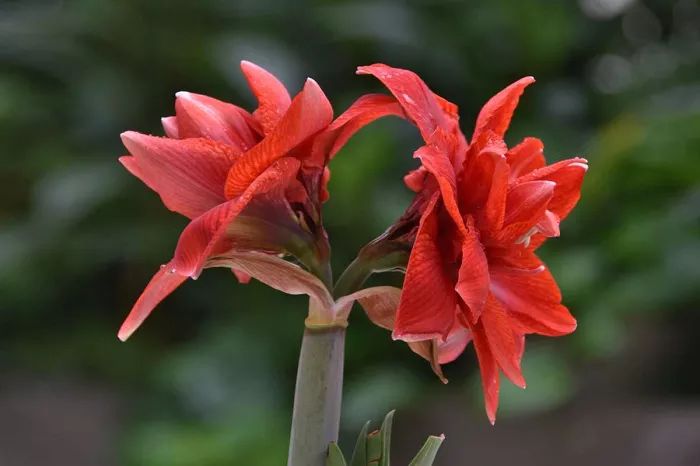Amaryllis, with its striking blooms and vibrant colors, is a beloved addition to any garden or home. Whether you’re a seasoned gardener or a novice, the anticipation of watching an amaryllis bulb transform into a stunning flower is part of the joy. But how long does it take for an amaryllis to flower? This question often puzzles many, and the answer lies in understanding the plant’s natural cycle and the conditions it thrives in. Let’s delve into the fascinating world of amaryllis and uncover the secrets behind its blooming timeline.
Understanding the Amaryllis Life Cycle
From Bulb to Bloom: The Natural Progression
Amaryllis bulbs are nature’s time capsules, containing all the energy and potential needed for a spectacular display. When planted, the bulb begins its journey towards flowering. Typically, it takes about 6 to 8 weeks from planting to blooming. However, this timeline can vary based on several factors, including the health of the bulb, environmental conditions, and care provided.
The Role of Dormancy
Before an amaryllis can flower, it must first complete a period of dormancy. This rest phase is crucial for the bulb to conserve energy and prepare for the next growth cycle. During dormancy, the bulb should be stored in a cool, dry place with temperatures around 50 to 60°F (10 to 15°C). This period usually lasts for about 8 to 12 weeks. Proper dormancy is essential for the bulb to reset its internal clock and ensure robust flowering.
Planting and Initial Growth
Once the dormancy period is over, it’s time to plant the bulb. Choose a well-draining potting mix and plant the bulb with about one-third of its height above the soil surface. Water the bulb thoroughly and place it in a warm, bright location. The initial growth phase begins with the emergence of leaves and the flower stalk. This stage can take around 2 to 3 weeks, during which the bulb absorbs nutrients and energy from the soil.
Flowering Time and Duration
The moment gardeners eagerly await is the flowering stage. After the initial growth phase, the flower stalk will elongate rapidly, and buds will form at the top. Depending on the variety and growing conditions, the buds will open into magnificent blooms within 1 to 2 weeks. Amaryllis flowers can last for several weeks, adding a touch of elegance and color to your space.
Factors Affecting the Flowering Time
Temperature and Light
Amaryllis thrives in warm temperatures, ideally between 68 to 75°F (20 to 24°C). Cooler temperatures can slow down the growth and delay flowering. Additionally, ample sunlight is crucial for the plant’s development. Place the pot in a location that receives 4 to 6 hours of bright, indirect light daily. Insufficient light can result in weak growth and fewer blooms.
Soil and Watering
Well-draining soil is essential for amaryllis, as it prevents the bulb from rotting. Use a potting mix specifically designed for bulbs or create your own by mixing equal parts of peat moss, perlite, and potting soil. Water the plant consistently, keeping the soil moist but not waterlogged. Overwatering can lead to bulb rot, while underwatering can cause the leaves to wilt and stunt growth.
Nutrient Requirements
Amaryllis bulbs store a significant amount of nutrients, but they still benefit from additional feeding. Apply a balanced liquid fertilizer every 2 to 3 weeks during the active growth phase. This will provide the necessary nutrients for the plant to produce healthy leaves and vibrant flowers.
Tips for Successful Amaryllis Flowering
Choosing the Right Bulb
Selecting a high-quality amaryllis bulb is the first step towards successful flowering. Look for bulbs that are firm, plump, and free from mold or blemishes. Larger bulbs tend to produce more flowers and stronger flower stalks. When purchasing bulbs, choose varieties that are well-suited to your climate and growing conditions.
Proper Planting Techniques
Planting the bulb correctly is crucial for its growth and flowering. Ensure that the bulb is planted with the pointed end facing upwards and about one-third of its height above the soil surface. This allows the roots to grow downward and the flower stalk to emerge without obstruction. Use a pot that is slightly larger than the bulb to provide adequate space for root development.
Post-Blooming Care
After the amaryllis has finished flowering, it’s essential to care for the plant properly to ensure it blooms again next year. Cut off the flower stalk about 1 to 2 inches above the bulb to prevent the plant from expending energy on seed production. Continue to care for the plant by providing water and fertilizer, and gradually reduce watering as the leaves begin to yellow and die back. This signals the start of the dormancy period.
Overcoming Common Challenges
Growing amaryllis can sometimes present challenges. One common issue is the failure to flower, which can be caused by insufficient dormancy, inadequate light, or improper watering. Another problem is the bending or breaking of flower stalks, often due to uneven watering or lack of support. To prevent these issues, ensure consistent care and provide support for the flower stalk if necessary.
Conclusion
The journey of an amaryllis from bulb to bloom is a fascinating process that can bring immense joy to any gardener. With proper care, attention to detail, and an understanding of the plant’s natural cycle, you can enjoy the stunning beauty of amaryllis flowers in just a matter of weeks. Whether you’re looking to brighten up your home or add a touch of elegance to your garden, amaryllis is a rewarding plant that will surely delight.


